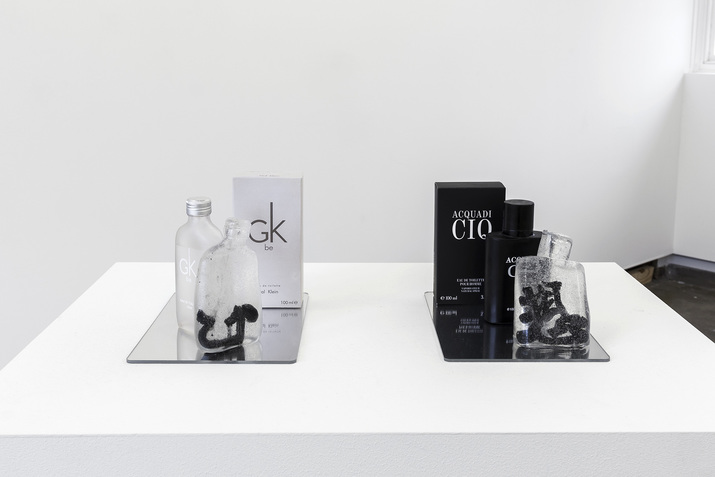
R
E
V N
E
X
T
Donning a long black wig, a silk dress, and white shoes, Chun Yin Rainbow Chan transformed herself into the persona of Chamele. In her performance Gloss (2019), staged at Sydney’s Cement Fondu in March, the artist entered the Project Space, where a giant poster of Chamele luxuriating on a red velvet lounge occupied the entire back wall. Mirrored plinths holding dainty bottles modeled after the iconic Chanel perfumes transformed the gallery space into a luxury retail shop. Upon closer inspection, however, these bottles are revealed to be made from jelly wax; the jewels adorning the plinths cheap plastic; and the two reversed C’s of the Chanel logo skewed. On another set of plinths were paper masks of Chamele. An electronic track began to play and Chamele, in the flesh, began to sing.
A musician since her teenage years and a music graduate of the University of Sydney, Chan created Chamele based on her lived experiences of a gendered, racialized music industry and its fixation on celebrity culture. Chamele is the embodiment of the hyperbolized, idealized, glamorized femininity expected of women musicians. In particular, Chan looks to theorists such as Robin James and her notion of “resilient femininity” in an industry that capitalizes on female struggle through cliché anthems of empowerment and songs of heartbreak by the likes of Beyoncé and Lady Gaga. James’s semiotic readings of pop music as serving up “patriarchal damage” for spectacle is incorporated in the track Chan composed for Gloss, featuring lyrics such as “you are so cute/you dry my tears/please do not hang up when you call.” Yet, performed in an autotuned robotic voice, the song has an eerie tonal quality. The glottal stops, glitches, and inhuman vocals render Chamele’s body as merely a controllable, empty vessel, to be filled with meanings devised within a fundamentally patriarchal industry that renders female emotion, trauma, and suffering into formulas for profit. James’s concept of patriarchal damage is visually manifested in videos of Chamele, which glitch and are manipulated so that her figure stretches and twists impossibly, commenting on the malleability of the bodies and identities of pop stars as they struggle to stay culturally relevant.
Chan made the leap from music to contemporary art in 2015, participating in group presentations at Firstdraft Gallery and the Underbelly Arts Festival in Sydney. “There were wider issues I wanted to explore and felt restricted in a musical sense,” she explained, when I visited her at Sydney’s 4A Centre for Contemporary Asian Art Creative Studios. “The [song] platform is usually three to five minutes and it can be very didactic to say [what I want to] in lyrics and words. The nature of the medium pushed me to recontextualize it within the gallery space or in digital spaces. There is more discourse in art around creative practice, unlike consumable pop songs.” That said, Chan—whose practice revolves around the deconstruction, disintegration, and eschewing of categories and labels—maintains that there is no distinction between the fields of contemporary art and music; the former merely provides a different opportunity to interrogate forces at play within the music industry and beyond.
At the heart of Gloss is an exploration of power, autonomy, and identity in relation to the market at large. As Chan elaborated: “Chamele is a porous entity commenting on power dynamics and hierarchies in every system. Whilst it is very obviously about celebrity culture, it is applicable across anything that you create and that is consumed. I am looking at consumption and production more broadly.” This is reflected in the name of Chan’s persona Chamele, based on a counterfeit perfume bottle the artist found labeled “Chamele No. 5.” Since 2015, Chan has been investigating the phenomenon of shānzhài, the counterfeiting of Western brands by Chinese companies. Chan specifically harnesses its ambivalence, exploring its “emancipatory potential” as an “alternate, parallel route” to satisfying the desires of those who cannot afford luxury goods. Chan emphasizes that while counterfeiting occurs worldwide, shānzhài represents a distinct Chinese phenomenon. The artist’s ongoing research for her Master of Fine Arts at the University of New South Wales focuses on China’s growing class disparities in the aftermath of its rapid transition to state capitalism. She observes: “China is unique in its status as the world’s manufacturer, the world factory. They are making counterfeits but, often, they are making the real products as well.” Chan’s materials mimic these contradictions, with the caprices of the market paralleled with the instability of the jelly wax used to create the artist’s counterfeit perfume bottles.
A function of shānzhài’s cultural specificity is the genre of humor derived from the typos and other distortions seen on the fakes owing to a poor command of English. As Chan jokes, “I used to wear ‘Nickey Nouse’ pyjamas and ‘Hello Knitty’ shirts.” These slippages in language are the subject of Chan’s Broken Vessel of 1996 (2016), performed at The Greek Centre for Contemporary Culture, Melbourne. In this work, Chan recounted immigrating to Australia from Hong Kong in 1996, speaking in Cantonese into her phone’s Google Translate application, which then translated her words into English. Tension filled the pauses between Chan speaking and Google Translate replying. As the application distorts tonalities, Google Translate frequently returned mistranslated and absurd phrases. While the bizarre comments express the aporia of language in translation, the humor belies a sense of the artist’s grief over her loss of fluency in Chinese after two decades in Australia. As Chan revealed in the performance, “When I speak with my mom and dad I often have to rely on the Google Translate app.” In To enclose one’s mouth (2017), performed at 4A Centre for Contemporary Asian Art, Chan similarly used Google Translate to transform an English poem she wrote into Chinese, which she then rendered in ink calligraphy onto a looped silk scroll. Chan alludes to her childhood memories of learning Chinese and the constant effort required to retain her linguistic knowledge through copying the poem ten times, turning the rote act into a poignant and nostalgic meditation on the loss of language through a diasporic lens.
Chan continued her exploration of cultures threatened by assimilation in the video installation A Kingdom of Flowers for My Mother (2018), centered on weitou, the first settlers of Hong Kong from Southern China. The widespread adoption of Cantonese in Hong Kong, alongside the prejudicial association of weitou speakers with the underprivileged and uneducated class, has led to a decline in matrilineal transmission of folk songs and practices. As Chan explained: “The practice stopped in the 1960s and 1970s. The songs themselves are disappearing because there are only a handful of women who know the songs but they cannot read or write so they cannot document it.” Shown at Firstdraft, A Kingdom of Flowers portrays weitou elders, including Chan’s mother and aunts, performing folk music and reciting stories. Chan’s upcoming performance A Kingdom of Flowers for My Mother: Part II, part of the program for the Sydney Contemporary art fair at Carriageworks this September, will see her teaching visitors weitou lullabies in an effort to preserve this cultural heritage. She explains that she “feels invested as a person of the diaspora; I am able to have a further perspective and to see the importance of certain things.” In revealing the identities that individuals are forced to perform or to hide, Chan not only lays bare the power structures that shape the cultural landscape, but also invites us to listen to the voices of the exploited and marginalized.


















